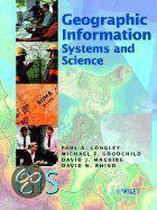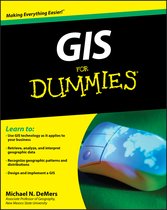GIS for Science Applying Mapping and Spatial Analytics, Volume 2
- Engels
- Paperback
- 9781589485877
- 04 februari 2021
- 232 pagina's
Samenvatting
GIS for Science, Volume 2: Applying Mapping and Spatial Analytics shows readers how scientists working on the world's most pressing problems apply geographic information systems—GIS.
GIS for Science, Volume 2: Applying Mapping and Spatial Analytics brings to life a continuing collection of real-world examples of scientists using geographic information systems (GIS) and spatial data science to expand our understanding of the world. They are part of a global effort to find ways to sustain a livable environment for all life on the planet. At Esri, we called this The Science of Where®, a concept that merges our impulse to dream, discover, and understand with the rigor and discipline of the scientific method and the foundation of geography. As such, GIS provides a framework for applying science to almost every human endeavor as we aspire to transform the world through mapping analytics.
The stories in this book are written for professional scientists, the swelling ranks of citizen scientists, and anyone interested in science and geography. The contributors represent a cross section of scientists who employ data gathered from satellites, aircraft, ships, drones, and myriad other remote-sensing and on-site technologies. This data is brought to life with GIS and the broader realm of spatial data science to study a range of issues relevant to our understanding of planet Earth and beyond. Scientists are documenting an array of geographically oriented issues ranging from climate change, natural disasters, and the loss of biodiversity to political strife, disease outbreaks, and resource shortages.
The examples in GIS for Science, Volume 2: Applying Mapping and Spatial Analytics show how ArcGIS® software and the ArcGIS® Online cloud-based system work as a comprehensive geospatial platform to support research, collaboration, spatial analysis, and science communication across many settings and communities. In these chapters, you’ll learn about sustainable precision agriculture, predicting geological processes below the surface of the earth, leveraging GIS near-realtime disaster response, recovery, resilience and reporting, the latest innovations in monitoring air quality and much more. These stories, along with the supplementary resources online, present GIS ideas and inspiration that users can apply across many disciplines, making this volume relevant to diverse scientific audiences.
Merging the rigor of the scientific method with the technologies of GIS
GIS for Science, Volume 2: Applying Mapping and Spatial Analytics brings to life a continuing collection of current, real-world examples of scientists using geographic information systems (GIS) and spatial data science to expand our understand of the world. Co-edited by Esri Chief Scientist Dawn Wright and Esri Technology Writer and Information Designer Christian Harder and with a foreword by Pulitzer Prize winner Jared Diamond, these case studies are part of a global effort to find ways to sustain a livable environment for all life on this planet.
The contributors of GIS for Science, Volume 2: Applying Mapping and Spatial Analytics represent a cross section of scientists who employ data gathered from satellites, aircraft, ships, drones, and myriad other remote-sensing and on-site technologies. This collected data is brought to life with GIS and the broader realm of spatial data science to study a range of issues relevant to our understanding of planet Earth—including epidemiology in light of the COVID-19 pandemic; sustainable precision agriculture; predicting geological processes below the surface of the earth; leveraging GIS near-realtime disaster response, recovery, resilience and reporting; the latest innovations in monitoring air quality; and more. Their stories also show in very practical terms how ArcGIS software and the ArcGIS Online cloud-based system work as a comprehensive geospatial platform to support research, collaboration, spatial analysis, and science communication across many settings and communities. A rich supplementary web site—gisforscience.com—includes actual data along with additional maps, videos, web apps, story maps, workflows and snippets of computer code, including Python notebooks, for readers curious to learn more.
Written for professional scientists, the swelling ranks of citizen scientists, and anyone interested in science and geography, GIS for Science, Volume 2: Applying Mapping and Spatial Analytics offers wonderful examples of our impulse to dream, discover, and understand, as coupled with the rigor and discipline of the scientific method and the foundation of geography. See how scientists from a variety of disciplines are solving some of the world's most pressing problems using geographic information systems—GIS.
Productspecificaties
Inhoud
- Taal
- en
- Bindwijze
- Paperback
- Oorspronkelijke releasedatum
- 04 februari 2021
- Aantal pagina's
- 232
- Illustraties
- Nee
Betrokkenen
- Hoofdredacteur
- Dawn J. Wright
- Tweede Redacteur
- Christian Harder
- Hoofduitgeverij
- Environmental Systems Research Institute Inc.,U.S.
Overige kenmerken
- Extra groot lettertype
- Nee
- Product breedte
- 254 mm
- Product lengte
- 279 mm
- Studieboek
- Nee
- Verpakking breedte
- 254 mm
- Verpakking hoogte
- 279 mm
- Verpakking lengte
- 279 mm
- Verpakkingsgewicht
- 225 g
EAN
- EAN
- 9781589485877
Je vindt dit artikel in
- Categorieën
- Boek, ebook of luisterboek?
- Boek
- Beschikbaarheid
- Leverbaar
- Taal
- Engels
- Studieboek of algemeen
- Algemene boeken
- Prijs inclusief verzendkosten, verstuurd door bol
- Ophalen bij een bol afhaalpunt mogelijk
- 30 dagen bedenktijd en gratis retourneren
- Dag en nacht klantenservice
Rapporteer dit artikel
Je wilt melding doen van illegale inhoud over dit artikel:
- Ik wil melding doen als klant
- Ik wil melding doen als autoriteit of trusted flagger
- Ik wil melding doen als partner
- Ik wil melding doen als merkhouder
Geen klant, autoriteit, trusted flagger, merkhouder of partner? Gebruik dan onderstaande link om melding te doen.








